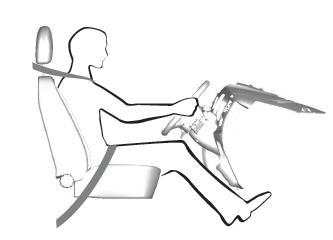Ford Escape: Pedestrian Alert System / Description and Operation - Pedestrian Alert System - System Operation and Component Description
System Operation
System Diagram
.jpg)
| Item | Description |
|---|---|
| 1 | PACM |
| 2 | PCM |
| 3 | IPC |
| 4 | Rear sounder |
| 5 | BCM |
| 6 | SOBDMC |
| 7 | Front sounder |
Network Message Charts
Module Network Input Messages - PACM
| Broadcast Message | Originating Module | Message Purpose |
|---|---|---|
| Factory mode | BCM | Controls the pedestrian alert system based on the vehicle build status set in factory mode. |
| Ignition status | BCM | Ignition RUN, START and accessory states required for the PACM operating modes and fault reporting. |
| Power pack status | SOBDMC | Determines the HEV operational state. |
| Reverse gear state | PCM | Determines reverse gear state. |
| Transport mode | BCM | Controls the pedestrian alert system based on the vehicle build status set in transport mode. |
| Vehicle speed | PCM | Engages the sounder between 0-30 km/h (0-8 mph). |
Module Network Input Messages - IPC
| Broadcast Message | Originating Module | Message Purpose |
|---|---|---|
| Pedestrian alert fault | PACM | Displays the pedestrian sounder fault warning message. |
Pedestrian Alert System
The pedestrian alert system provides an audible alert when the vehicle is moving in forward or reverse between 0-30 km/h (0-8 mph). The PACM receives all network messages required to operate the system over the HS-CAN1 .
In the event of a system fault, the IPC message center displays the Pedestrian Alert Fault Service Now warning message in the message center. The IPC receives the pedestrian alert fault message from the GWM over the HS-CAN3 . The GWM receives the pedestrain alert fault message from the PACM over the HS-CAN1 .
Component Description
PACM
The PACM controls the pedestrian alert system and is capable of setting Diagnostic Trouble Codes (DTCs) when a fault condition is detected. The PACM requires PMI when replaced.
 Description and Operation - Pedestrian Alert System - Overview
Description and Operation - Pedestrian Alert System - Overview
Overview
Due
to the quiet nature of vehicles operating in electric mode, pedestrians
may not be aware of the presence and operation of the vehicle, creating
a risk for injury...
 Diagnosis and Testing - Pedestrian Alert System
Diagnosis and Testing - Pedestrian Alert System
Diagnostic Trouble Code (DTC) Chart
Diagnostics in this manual assume a certain skill level and knowledge of Ford-specific diagnostic practices. REFER to: Diagnostic Methods (100-00 General Information, Description and Operation)...
Other information:
Ford Escape 2020-2025 Service Manual: Description and Operation - Direct Current/Alternating Current (DC/AC) Inverter - System Operation and Component Description
System Diagram System Operation Network Message Chart Broadcast Message Originating Module Message Purpose Power pack torque status Secondary On-Board Diagnostic Control Module C (SOBDMC) Used to determine if the vehicle is started or if torque is available...
Ford Escape 2020-2025 Service Manual: Removal and Installation - Charge Port - Plug-In Hybrid Electric Vehicle (PHEV)
Removal WARNING: To prevent the risk of high-voltage shock, always follow precisely all warnings and service instructions, including instructions to depower the system. The high-voltage system utilizes approximately 450 volts DC, provided through high-voltage cables to its components and modules...
Categories
- Manuals Home
- 4th Generation Ford Escape Owners Manual
- 4th Generation Ford Escape Service Manual
- Plug-In Hybrid Electric Vehicle Drive Modes
- Drive Modes
- Symbols Glossary
- New on site
- Most important about car
Sitting in the Correct Position

When you use them properly, the seat, head restraint, seatbelt and airbags will provide optimum protection in the event of a crash.

.jpg)